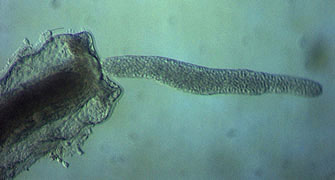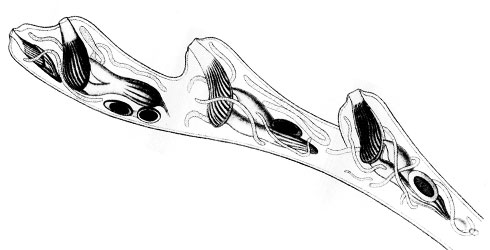Biology
Many aspects of its biology are still not understood. Surprisingly, it is now believed to be a highly modified member of the cnidarians (corals, hydras, jellies).
B. plumatellae worms occur in the body cavities of freshwater bryozoans, where they either swim around freely or are attached by one end to the body wall or gut tissue of their host. They can perform undulating movements.
Size
- Worms: < 2 mm long, ~0.1mm in diameter
- Spores: +/- spherical, 10-15µm in diameter
Lifecycle

Buddenbrockia plumatellae worm leaving bryozoan host. Light micrograph (Photo: S. Tops).
Worms occur very seasonally, in temperate zones mostly for a few weeks in early summer and in autumn. This seems to correlate with the seasons of best nutritional conditions of the bryozoans hosts during plankton blooms in their aquatic habitats. However, it is very likely that cryptic stages persist in the hosts for longer times. Also the life-cycle probably includes a second host species, most likely a fish (see Biotic Interactions).
Life Expectancy
The worms are short-lived. After spore maturation they usually leave the host and rupture soon, releasing spores.
-

Reproduction
While there is a lack of knowledge regarding the reproductive processes of Buddenbrockia plumatellae, find out what is currently known.
